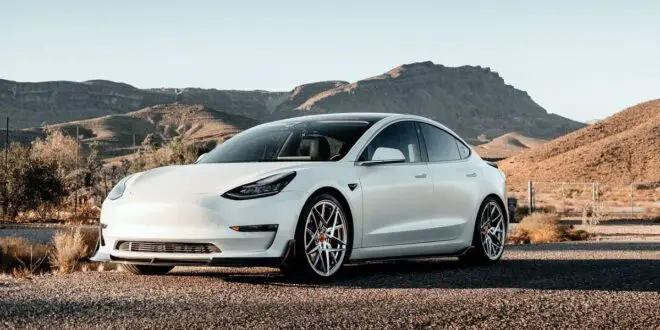When it comes to cars, there are several driving systems out there, such as All-Wheel Drive (AWD), Front-Wheel Drive (FWD), Rear-Wheel Drive (RWD), and even 4-Wheel Drive (4WD). These driving systems all have their good and bad, which means they are preferred by some drivers. However, what about Tesla? Are Tesla cars AWD, FWD, or RWD?
In general, all Tesla models are AWD or come with RWD options. Tesla Model S, X, and Y come in only AWD, while the Model 3 has either AWD or RWD options. The AWD option tends to be more expensive than the RWD option by over $15,000. Tesla’s AWD cars have better range and performance than RWD cars.
In this article, we explore if all Tesla models are AWD. We also look at AWD and how it differs from other driving systems such as RWD, FWD, or 4WD. We then examine how Tesla’s AWD system works and explore why people love AWD cars.
What Is AWD?
AWD stands for All-Wheel Drive. It is a driving system where the engine can deliver power to all the wheels in the car. AWD is the overarching system that also includes 4-wheel and 6-wheel drives. AWD cars have better traction and are useful when driving on bad roads or when there is mud, rain, or snow.
The simplest way to describe an All-Wheel Drive (AWD) system is that it can deliver power to all its wheels, by demand. This means if the vehicle has 4 wheels, the moment you step on the gas, the engine delivers rotational power to all 4 wheels.
You can assume the same if the vehicle also has 6 or 8 wheels. The most common forms of AWD are 2X2, 4X4, 6X6, and also 8X8. In this formula, the first digit indicates the number of wheels, and the second digit refers to how many of these wheels can receive power from the engine.
You may be most familiar with a 4X4 system, which many also call the 4-Wheel Drive (4WD).
More modern cars may have adjustable AWD, meaning the car can switch from FWD or RWD to AWD when needed. This can be done by pressing or flicking a switch, or pulling a lever in the car cabin.
Systems like these are called Part-Time or On-Demand AWD. You may see such systems being offered on more rugged SUVs such as Toyota Land Cruiser, Jeep Wrangler, or Ford Bronco.
AWD drive systems are loved by many due to their better grip, which means they will provide good traction on the surface. This makes AWD systems indispensable to Overlanding vehicles or where road conditions are bad. AWD cars are also excellent for driving in wet, muddy, and snowy conditions.
AWD cars are also appreciated by the racing community, as the better grip on the road allows cars to launch and take turns at higher speeds. Most performance cars are AWD.
However, AWD systems are not known to be fuel-efficient, resulting in many common consumer-level cars not being equipped with them. Most consumer-level cars come in FWD.
What Are The Types Of AWD?
There are two major types of AWD, mechanical and electrical. More modern cars use electrical AWD, which may rely on sensors to detect grip issues of slippage and adjust power delivery accordingly to ensure safe driving.
The most old-school AWD driving systems may be seen in older Toyota Land Cruisers. You practically have to stop your car, get out of it, and then perform some adjustments on the wheels to turn it into AWD.
Things have improved these days, with most AWD systems engageable via the press of a button. In fact, this is the baseline for most part-time AWD systems today. The difference lies in how smart they are.
Mechanical AWDs tend to be what they are. You turn it on, the systems engage, and you have power to all your 4 wheels. That is basically it. Such systems are good if you just need a simple, and reliable AWD system, say if you just need it to occasionally get your car out of the mud.
However, if you want an AWD to make your car safer, get the electrical AWD. These usually come with sensors on the wheels to detect slippage or loss of traction. If the car detects a loss of grip, it will reduce power delivery to the wheel and send more to the opposite side of the wheel.
This prevents your cars from losing traction or drifting. This may be very important if you drive in the rain or when it is snowy and icy.
AWD vs. FWD vs. RWD
AWD, FWD, and RWD differ in many ways, such as power delivery, complexity, fuel efficiency, traction, safety, and handling. As such, all driving systems have their strengths and weaknesses and are preferred by their own group of drivers.
| AWD | FWD | RWD | |
| Power Delivery | All wheels | Front wheels only | Rear wheels only |
| Complexity | Most Complex | Simplest | Complex |
| Fuel Efficiency | Least efficient | Most Efficient | Efficient |
| Traction | Most Traction | Medium Traction | Less Traction |
| Safety | Safest | Safer | Safe |
| Handling | Best | Medium | Good |
| Acceleration | Best | Medium | Better |
Comparing AWD, FWD, and RWD against each other may not be straight apples to apples. This is because there may be other factors that can get into play, and influence how these systems perform.
For example, a car with its engine up front may perform much better as an FWD than an RWD. However, a car with an engine at the back may perform better as an RWD than as an FWD.
There are also factors such as if the cars come with suitable tires or are equipped with mechanical or electronic driving systems.
The comparison here is based on a standard sedan car, with a front engine and regular safety systems such as the Antilock Braking System (ABS) or Traction Control.
Power Delivery
AWD delivers engine power to all the wheels in the car, while FWD only delivers power to the front wheels. The RWD delivers power to the rear wheels.
Complexity
AWD may be the most complex, with the RWD second, while the FWD is the easiest. This is because, with AWD, mechanisms need to be put in place to deliver power to all four wheels.
With RWD, a system needs to be in place to deliver power to the rear wheel, which is far from the engine up front. FWD tends to be the simplest, as the wheels are right underneath the engine.
Fuel Efficiency
AWD may be the worst in fuel efficiency, while FWD may be the best. This is because by powering all four wheels, more fuel is needed. For FWD, the power is delivered to the front wheels only, reducing the needed output. On top of that, the close distance between the front wheels and the engine reduces power loss.
Traction
AWD has the best traction, followed by FWD and RWD. This is because power is delivered to all four wheels, meaning there may be more grip on the surface. FWD may win out over RWD because the front wheels have more weight, thanks to the engine. This increases grip and traction.
Safety
AWD is usually seen as the safest, as it has the most traction. This means more control and more safety. Understeering may happen in FWD systems, while you may oversteer in RWD systems.
However, experts have always suggested that understeer is the lesser evil of the two. However, modern cars have systems such as traction control, which can negate these issues.
Handling
AWD handles better than FWD or RWD. The reason is that AWD systems have better traction and control, meaning handling will be better. There is a reason why performance cars are all AWD.
RWD may handle better because the wheels are not weighed down by the engine, meaning steering becomes easier.
Acceleration
AWD accelerates better, as all the wheels can deliver power to the ground, helping the car to accelerate faster. RWD may perform better than FWD.
This is because when accelerating, the car may ‘squat,’ with the back of the car tilting slightly down than the front. This increases grip and allows the rear wheel to deliver more power to the ground and accelerate.
Suppose you apply the same situation to an FWD car. In that case, tilting actually reduces grip on the front wheels, meaning less acceleration.
Why Do Many People Love AWD Cars?
In general, people tend to appreciate AWD cars for their excellent grip, traction, and safety. As a result, you tend to see AWD cars on higher-priced models, rugged vehicles, and also performance cars.
Better Traction
AWD cars deliver rotational power to all four wheels, meaning there is a chance for all four wheels to have some traction. This is much better than FWD or RWD cars, whose front and back wheels only can deliver traction.
AWD systems are a standard feature in many Overlanding, rugged vehicles such as Toyota Land Cruiser, Ford Bronco, or Jeep Cherokee. These cars need AWD to navigate muddy and snowy roads and very uneven road surfaces.
Safer
Since AWD cars deliver traction to all four wheels. This means in an emergency, the onboard computer system has more opportunities to deliver power to support the driver.
Suppose the driver steers to the right hard to evade something. In an FWD or RWD system, only two wheels can be used to deliver power to the road. This means the onboard computer system has limited ways to steer the car back to safety, as it can only control two wheels. It may still be able to do the job, but it may take longer.
With AWD, the computer can regulate power delivery to all four wheels to stabilize the car faster, keeping the car and the driver safe.
Better Performance
AWD cars are also used in performance cars. This is because when power can be delivered to all four wheels, there is more traction, and more power can be delivered to the ground. This means AWD cars can accelerate better.
With more traction and grip, the car can also undertake cornering at a higher speed, as the wheels can keep the vehicle planted to the ground.
Are AWD And 4WD The Same?
AWD and 4WD are similar types of driving systems, with subtle differences. Some include AWD can refer to power delivery to all wheels, while 4WD means delivering power to 4 wheels. 4WD also tends to be part-time, while AWD is usually full-time.
In general, people tend to confuse AWD and 4WD. This is acceptable since they can be similar yet subtly different.
AWD and 4WD may refer to delivering power to all wheels in the car. However, since AWD does not specify a number, it can mean more than just four wheels. In fact, AWD systems can be 1X2, 2X2, 4X4, 6X6, or even 8X8.
4WD indicates power delivered to all four wheels and is the most common AWD system. Therefore, you may assume that 4X4 is the same as the 4WD system.
Another way to differentiate between AWD and 4WD is the adjustment. AWD tends to come as a full-time system, meaning the system runs all the time. 4WD, meanwhile, tends to come as a part-time system, meaning the system can be engaged only when needed.
For example, Tesla Model X’s AWD system cannot be changed into an RWD or an FWD system at will.
However, with a Toyota Land Cruiser, you can change the drive settings from an FWD to an AWD system with the press of a switch. This is why you see Toyota marketing their Land Cruisers as a 4WD, not an AWD.
What Are The Available TESLA Models?
Tesla had many models on sale, such as the Model S, X, Y, and 3. The first ModelModel of Tesla, the Roadster, is no longer on sale. Future models such as Cybertruck, Tesla Semi-Truck, and the new Roadster are either in development or scheduled to go on sale soon.
Tesla is a major automobile manufacturer that punches far above its weight. This is probably due to its approach of producing electric vehicles (EV) and not traditional combustion engine vehicles.
It currently has several models on sale, with more scheduled to begin production soon:
Tesla Model S
The Model S is a five-door sedan with a liftback tailgate. It is Tesla’s earliest successful model after the Roadster. It was the first full EV to top monthly sales ranking in any country and set the benchmark for future EVs.
Tesla Model Y
Model Y can be considered a smaller version of the Model X. It is a compact crossover SUV. The platform is similar to the Model 3 and can be configured to seat 7 people.
Tesla Model X
The Model X is a mid-size crossover sports utility vehicle (SUV). You can select between 5, 6, or 7-passenger configurations, and it comes with only AWD. The Model is most well known for its doors. It opens upwards instead of sidewards like common cars. Tesla has called this the ‘falcon-wing’ design.
Tesla Model 3
It is a sedan with a fastback, four-door design. Tesla aims the car for common consumers who just want a reliable EV to go around. It was the best-selling electric vehicle in history, with sales reaching 1 million units in June 2021.
Tesla has also announced that they intend to develop and release future models. These include the pickup truck Tesla Cybertruck, Semi-Truck Tesla Semi-Truck, and also a new edition of the Tesla Roadster.
Are Teslas AWD?
All Tesla models are either AWD or come with AWD options. Tesla Model X, S, and Y come in only AWD, while the Model 3 has either AWD or RWD options. The AWD option tends to be more expensive than the RWD option, by about $15,000. Tesla’s AWD cars have better range and performance than RWD cars.
| Model | Driving System | Price |
| Model X |
|
112,990 to $138,990 |
| Model Y |
|
$65,990 to $69,990 |
| Model S |
|
$104,990 to $135,990 |
| Model 3 |
|
$46,990 to $62,990 |
Tesla cars come mostly as AWD models, although you may opt for RWD systems for some cars. Some models only come in AWD due to their weight and performance requirements, which makes RWD systems a little unsuitable.
When looking at the pricing of the AWD and RWD models, AWD models tend to be more expensive, by several thousand dollars. This makes sense since an AWD system is more complicated than RWD, which may make it cost more on Tesla’s end.
Tesla Model S
Tesla Model S only comes in AWD. However, you may choose between having a dual-motor AWD or a tri-motor AWD. Tri-motor models may have higher horsepower, acceleration, and top speed but a lesser range.
A dual-motor model may last you up to 405 miles (651KM approx.), while the tri-motor model can go up to 396 miles (637KM approx.) before requiring charging. Prices start from $104,990 to $135,990.
Tesla Model Y
Tesla Model Y comes only in AWD, similar to Model S. You can, however, choose between the performance or the Long Range model. Performance models may have better acceleration and top speed, with slightly lesser range.
Performance models have a range of 303 miles (487KM approx.), while the Long Range model may last you up to 330 miles (531KM approx.). Prices start from $65,990 to $69,990.
Tesla Model X
Tesla Model X only comes in a dual-motor AWD system, similar to both Model Y and S. You can choose between the Long Range or the Performance model. Performance model offers better horsepower, acceleration, and top speed, at the cost of a lesser range.
A Performance model may last you up to 335 miles (539KM approx.), while the Long Range model may last you up to 351 miles (564KM approx.). Prices start from $112,990 to $138,990.
Tesla Model 3
Tesla Model 3 comes in two choices. You can opt for an RWD or a dual-motor AWD. The RWD is significantly cheaper, starting at $46,990. The AWD option starts at $62,990.
The RWD model has a lower range, acceleration, and top speed than the AWD version. It can only last you up to 272 miles (437KM approx.) before needing recharging, compared to the AWD model, at 315 miles (506KM approx.).
How Does Tesla’s AWD System Work?
Tesla’s AWD system works slightly differently than standard AWD because it is an electric vehicle. Two motors are in the car, one at the front and one at the rear. A computer system delivers power to the wheels based on the feedback its sensors receive. The most efficient wheel gets the most power, and vice versa.
Tesla’s AWD system may work slightly differently than common vehicles simply because it is not an internal combustion engine. This means Tesla can leverage technology to make its AWD system more efficient.
Tesla starts by placing two motors into the car, one at the front and one at the back. This evens out the car’s weight distribution, allowing for better performance. This negates some of the issues common AWD cars face. Since the engine is heavy, placing it up front makes the car front heavy, and vice versa.
Tesla also uses more technology in the car. Its software, with the help of sensors, helps to detect which wheel gets the most grip on the surface. It then delivers more power to the wheel.
Such a system helps the car to achieve the most traction and control while using the least power. As a result, Tesla can extend the range of its cars.
 Being Human
Being Human





